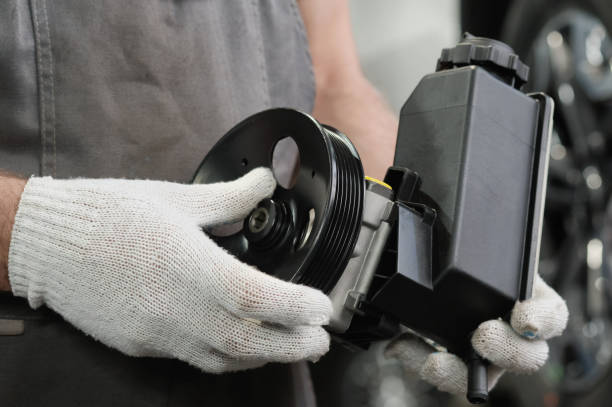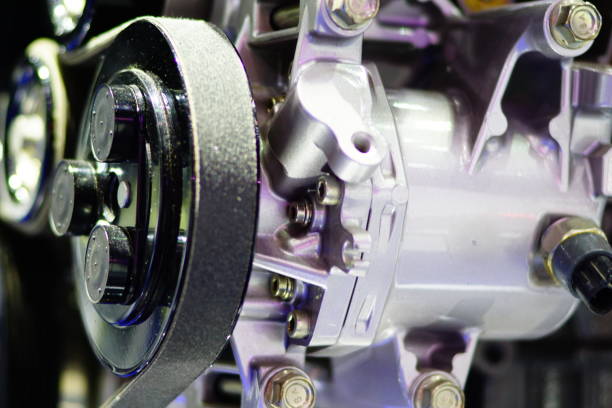Most power steering systems use a hydraulic pump and valves to pressurize the hydraulic fluid that helps the driver turn the steering wheel, so this part is considered the heart of the system. But like other car parts, the power steering pump can wear out over time, causing many frustrating problems. So power steering pump replacement is a necessary task drivers should do in this situation, but how is the process? Let’s follow us and find out:
Contents
How Do You Know If Power Steering Pump Is Bad
Except for the newest vehicle designs that use electric power steering, the hydraulic pump is mostly equipped for the power-assisted steering system. The pump is turned continuously when the engine is on, generating high pressures in the power steering fluid to make it easier for us to turn the steering wheel.
The power steering pump receives power from the engine via a belt, creating the necessary oil pressure. When steering, the distribution valve will send oil pressure to the cylinder, causing the piston to push the rack in the direction of the steering wheel rotation.
The pressure difference between the two piston heads will create a thrust force that helps reduce the driver’s impact force on the steering wheel. Because the pump receives power from the engine, the hydraulic power steering system only operates when the engine is started.
Play an important role in the power steering system, so what will happen If your power steering pump goes bad?

1. Squealing noise upon startup
This is a typical sign of a loose accessory belt, but it may also be a sign that the power steering pump is failing. You might hear some strange noises as the power steering pump wears out. The most common complaint is squealing or whining which becomes more noticeable when turning the steering wheel.
You may also notice the sound when starting the engine for the first time. The pitch of the sound can increase when the RPM increases. Furthermore, as the serpentine belt that drives the pump becomes loose and weakened, it can make a similar noise.
Additionally, loud noises when turning the steering wheel usually mean that the vehicle’s power steering system is low on fluid or that the power steering pump is malfunctioning and not working properly.
2. Heavy or stiff steering
The second symptom you may experience when the power steering pump fails is a hard steering wheel. Since the pump is responsible for increasing fluid pressure in the system, If it fails, there will be insufficient pressure in the power steering system to make minor adjustments. The wheel becomes heavy and the steering may become impossible.
3. Fluid leak
The fluid leak can come from a crack in the pump housing or the pump seals. The color of the power steering fluid will be red just make sure that you will not confuse it with transmission or coolant fluid. If the fluid level is consistently low, even after topping it off, there could be a leak or the pump might be consuming fluid due to internal damage.
You can encounter These three main symptoms when the power steering pump is bad. Additionally, there are other signs like:
- Metal flakes in the power steering fluid reservoir
- The power steering symbol on the dashboard
- Rough or jerky steering
If you experience any of these symptoms, it’s time for your power steering pump to be inspected or replaced. Driving with a failing power steering pump can be dangerous and lead to further damage to your vehicle.
Power Steering Pump Replacement: How To Do?
The process will be similar for most vehicles. Replacing the pump in the power steering system seems like an extremely challenging task at first but it doesn’t have to be and you can do it by yourself if you have car knowledge since it can be a rewarding and cost-effective DIY project. So how to replace power steering pump:

Step 1: Get your tools ready
You’ll save yourself a lot of time by gathering everything you need before you start:
- A new power steering pump
- A socket set, wrenches, screwdrivers
- Power steering fluid
- A power steering fluid catch pan and a funnel
- Jack stands
Note: Safety first: Always disconnect the negative battery terminal before working on any part of your vehicle’s electrical system.
Step 3: Locate the power steering pump
Do you know where the power steering pump is located in your car? It is located towards the front of the engine and is driven by the serpentine belt, V-belt, or, in most cases, directly by the crankshaft via a belt. In some models, the pump will be at the bottom of the engine close to the firewall, and you need to remove the plastic wheel well to get to it.
Step 4: Jack up your car
Depending on your vehicle’s design, the power steering pump might be located in a tight spot that’s difficult to reach from underneath. Jacking up the car gives you more room to work and see your actions.
Step 5: Flush the power steering fluid
Replacing the power steering pump is like getting a new heart for the steering system, so you don’t want to put a new heart into a body filled with old and dirty fluid, right? Flushing the power steering fluid is like that, it will give a new pump a clean environment to operate.
To do it, we’ll need to flush the system by disabling the engine from starting and disconnecting the return line to the pump crank. The engine pushes the old contaminants out through the return line once you see clear power steering fluid flowing and reconnect the hose. The system has now been flushed. You can see how critical this flushing process is since the old fluid can accumulate contaminants over time and can damage the internal parts of the new pump.
Step 6: Remove the old power steering pump
Now the system is flushed, we can start to remove the pump. How to remove power steering pump?
The first thing we need to do is remove the tension on the belt by loosening the adjustment bolts. Check it visually for cracks or other damage. In most cases, you will need to replace the power steering belt.
In this step, you need to make sure that there are no connections to the power steering pump such as a fluid level sensor.
After that, we will remove the pulleys and bolts that connect the pump to your car by using the correct tools. Finishing all these steps you can remove the old pump from the system.
Step 7: Install a new pump
The necessary thing you need to do in this step is to compare the new pump to the old one to make sure that they are identical by looking at the ports. If you replace the pulley, compare the diameter and count the grooves to make sure they match the old pulley.
Then carefully position the new pump onto the engine block, aligning it with the mounting holes. Install the mounting bolts and tighten them to the specified torque.
Step 8: Reconnect the hoses and lines
Reconnect the power steering hoses and lines to the new pump, ensuring they are securely fastened. Use new crush washers or O-rings if necessary to prevent leaks.
Step 9: Reinstall the belts
Route the serpentine belt(s) back onto the pulleys, including the power steering pump pulley. Use the belt tensioner tool to apply the correct tension.
Step 10: Add the fluid and test drive
Remove the cap from the power steering fluid reservoir and fill it with the correct type of fluid. After that, take your vehicle for a test drive, paying attention to the steering feel.
Now, your job is done. Please note that before deciding to replace the power steering pump, you should carefully check the pump, because in some cases, all you need is the power steering pump repair instead of replacing it.
Watch more:
Power Steering Pump Replacement Costs
The average cost for power steering pump replacement is between $500 and $1000. Parts may account for approximately half of the total cost, with the labor accounting for the remaining portion. You would only have to pay for the parts if you could replace the power steering pump by yourself. Most models require two to three hours to change the pump, but this varies greatly depending on the vehicle. It may be more difficult to replace a power steering pump on a front-wheel drive If the pump is located on the motor’s side.
Replacing your power steering pump can be a challenging but achievable DIY project. By following these steps carefully and consulting your vehicle’s repair manual, you can save money and enjoy the satisfaction of fixing your car yourself.



